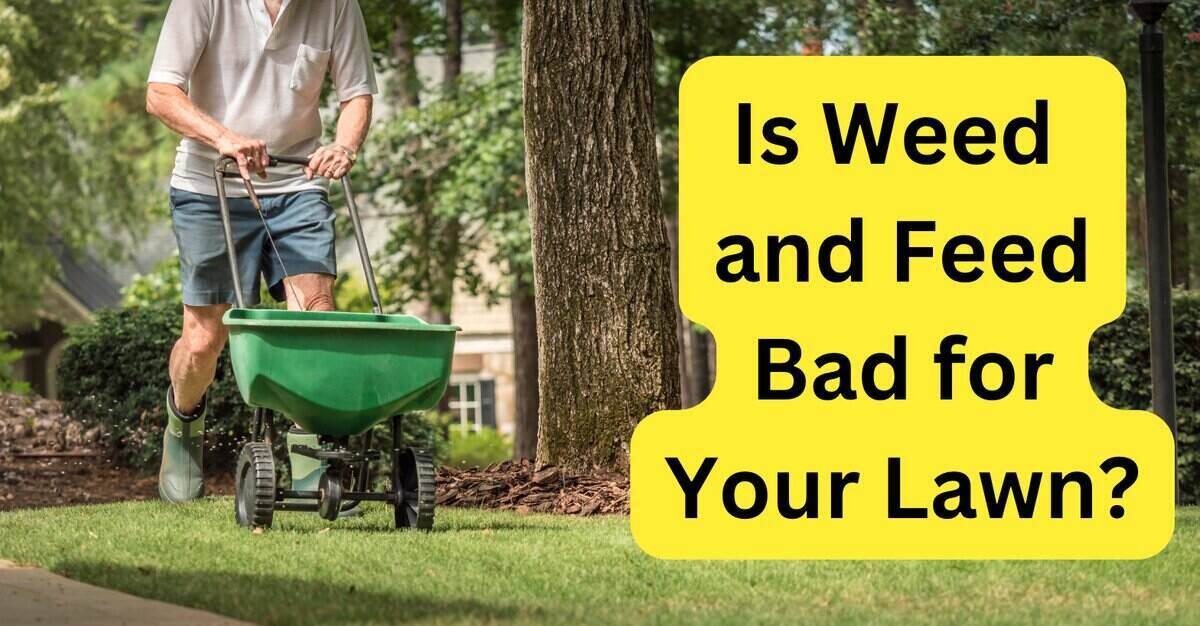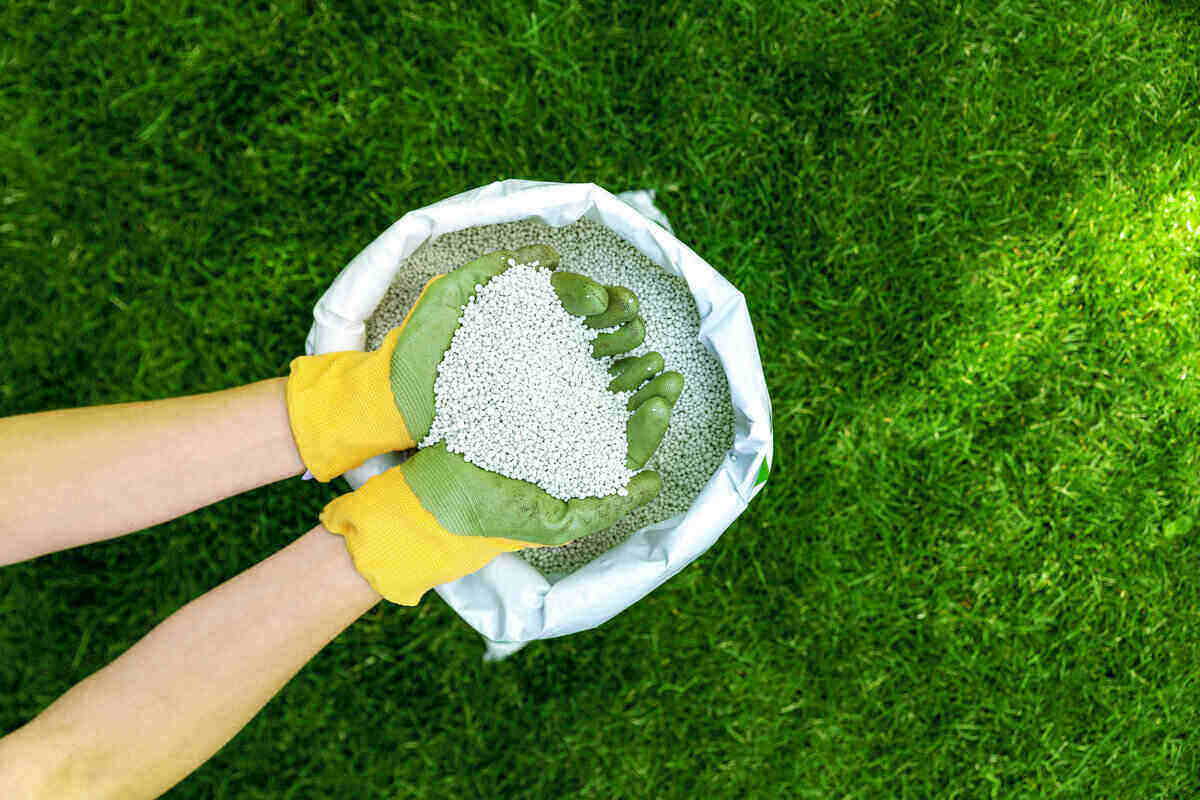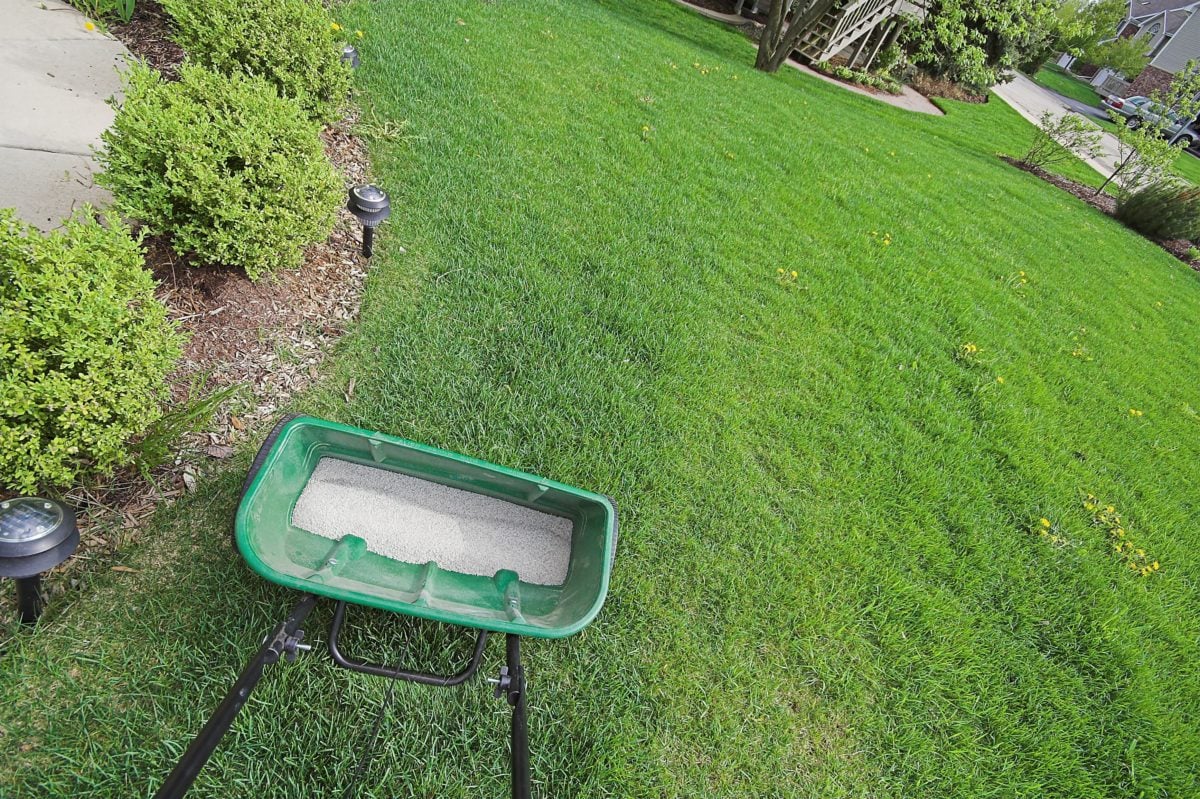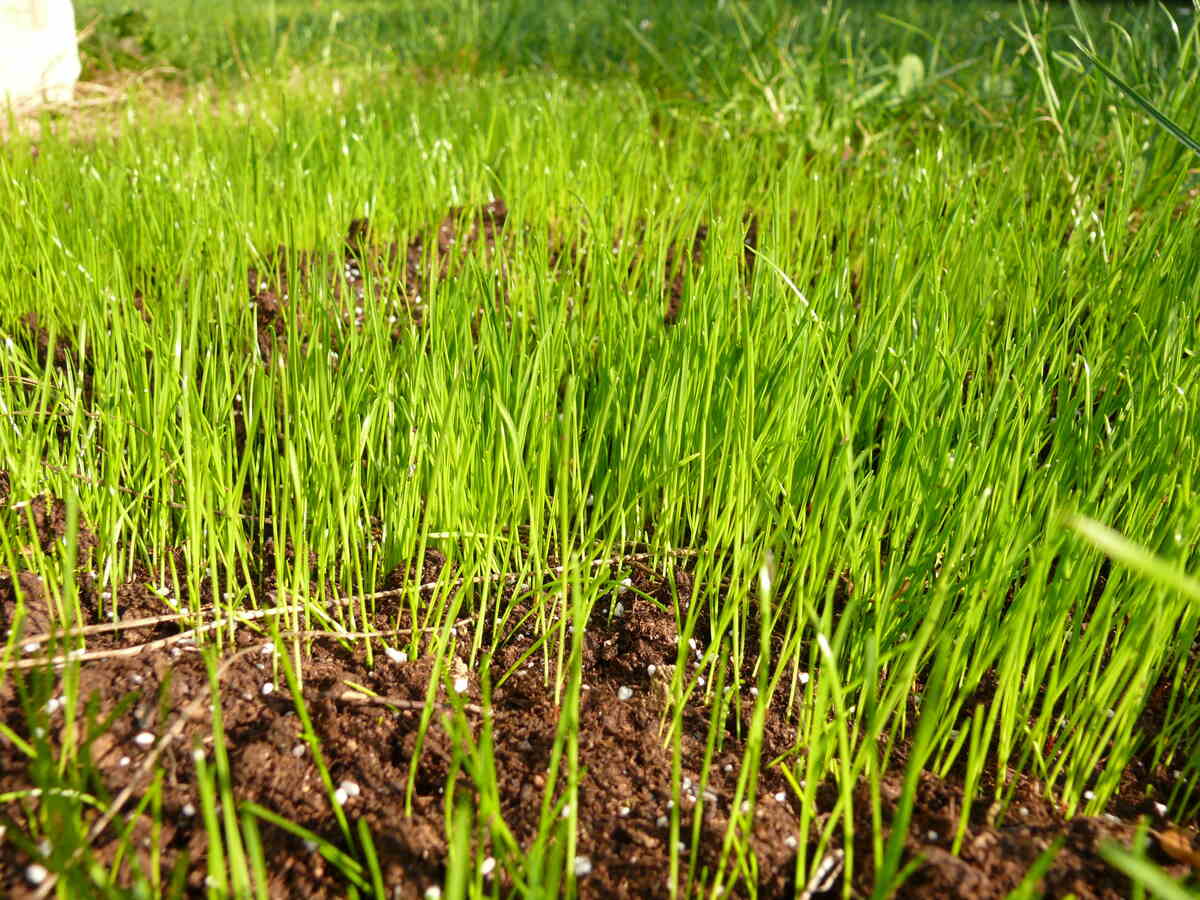
Young plants need fertilizer to grow strong and healthy, but when applied incorrectly, fertilizers can kill new grass. The most common cause of fertilizer damage in new grass is using too much starter fertilizer or spreading a weed and feed too soon after planting.
Planning to spread grass seed or install new sod in your yard? Read this guide to learn all about applying fertilizer in new lawns, how to avoid killing the grass, and covering the yard in a stunning, robust, and lush turf.
How Can Fertilizer Kill Grass
There are two ways you can kill grass with fertilizer: applying too much and using the wrong kind.
Applying Too Much Fertilizer
There are many little gestures during the fertilization process that can lead to you spreading more fertilizer on your lawn than you should. This is damaging because of the salts commercial lawn fertilizers contain. When these salts gather in the soil, they change water behavior in a way that harms grass seeds and plants:
- If fertilizer salts gather around grass seed in large amounts, they prevent moisture from reaching the seed. Deprived of water, the seed dehydrates and doesn’t germinate. This is how you get bare spots in a new lawn.
- Salts surrounding the roots of germinated grass plants prevent roots from absorbing water and new sprouts dry out and die. We call this “fertilizer burn” or “nitrogen burn” because nitrogen is the highest amount in most NPK fertilizers.
Since its roots are barely developed and struggling to absorb water and nutrients, new grass is even more susceptible to fertilizer burn than established turf.
What does grass killed by fertilizers look like? Fertilizer burn signs are similar to drought stress:
- Discolored grass blades
- Bare spots where new grass should be
- Patches of yellow or brown grass that look like scorch marks
- Grass is crispy or crunchy to the touch
- Checkerboard-like shapes, with burned areas in the middle of each square may appear as a result of fertilizer overlap
Overfertilization also harms the grass long term. When too much nitrogen is applied early in the growth process, grass focuses more on growing leaves than developing roots. The new turfgrass grows weak and thin, vulnerable to drought, weeds, pests, and diseases.
Applying Weed and Feed
Another way to kill new grass with fertilizer is to use a weed and feed formula. Weed and feed are 2-in-1 products that deliver nutrients and herbicides in the same application. If the herbicide is pre-emergent, it prevents the grass seed from forming its first roots, and the seeds will fail to sprout.
Some weed and feed products include selective post-emergent herbicides meant to kill only the weeds and not the grass. While grass in established lawns is relatively safe from selective herbicides, new grass is not no matter if seeded or installed as sod.
The bottom line? Don’t use weed and feed instead of starter fertilizer or you’ll end up with a patchy lawn.
Note: Hold off on any herbicide treatments on a newly seeded lawn for six to eight weeks after planting. If you already spread a herbicide, check the product package for how long you need to wait until you can seed or install sod.
Does New Grass Need Fertilizer?
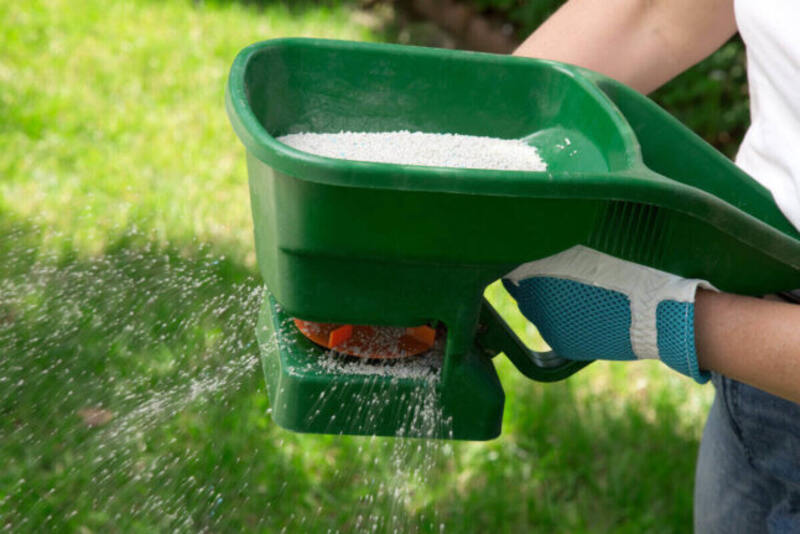
Grass seeds only need warmth and water to germinate. Each plant has enough nutrients in its seed to grow the first roots and leaves. But soon after germination, sprinklings extend their newly formed root system into the soil, searching for food.
Right after sprouting, their small roots have a hard time probing the ground and are limited to a small area around the grass plant for feeding. Here’s where fertilizers come in. Applying fertilizer right before or after seeding the lawn ensures the presence of precious nutrients close to turf roots, easy to absorb and use.
Can new turf grow without fertilizer? Sure, but not as well as with the additional food you provide. Without a proper fertilizer to boost growth, new grass grows thinner, slower, and weaker, and is more prone to diseases and pests.
Apply the Right Fertilizer for New Grass
Lawn fertilizers provide a mix of nitrogen (N), phosphorus (P), and potassium (K) in various ratios. Each of these essential macronutrients plays an important role in grass development:
- Nitrogen (N) primarily supports stem and leaf growth. It gives grass its intense green color and impacts growth speed.
- Phosphorus (P) is essential for root growth and disease resistance. It helps new shoots develop proper roots and also can help grass affected by a root pest or disease recover faster.
- Potassium or potash (K) protects the overall plant health, supports the plant’s metabolic functions, and makes turf more resistant to diseases (see “What Does Potassium Do for Your Lawn?”).
Turf fertilizers come with various NPK ratios, but it’s the phosphorus content that divides them in two general categories: starter fertilizers for new grass and regular fertilizers for established lawns.
Starter Fertilizer vs. Regular Fertilizer
New lawns have different nutrient requirements than established lawns. The best fertilizer to use for a new lawn is a starter fertilizer. Starter fertilizers have a higher amount of phosphorus essential for root development in young plants and a more balanced NPK ratio.
The best lawn fertilizer ratios for new grass are:
- 10-10-10: 10 parts nitrogen, 10 parts phosphorus, and 10 parts potassium
- 16-8-8: 16 parts nitrogen, 8 parts phosphorus, and 8 parts potassium
- 20-10-10: 20 parts nitrogen, 10 parts phosphorus, and 10 parts potassium
Here are some good starter fertilizers to consider:
- GreenView 2129800 Starter Fertilizer
- Covington Liquid 10-10-10 Fertilizer for Lawns, Plants, Vegetables, All Purpose Fertilizer
- Scotts Turf Builder Starter Fertilizer for New Grass
- Jonathan Green & Sons Seeding & Sodding Lawn Fertilizer
- Pennington UltraGreen Starter Lawn Fertilizer
Will regular fertilizer kill new grass? If applied correctly, regular fertilizer won’t kill your newly sprouted lawn, but it won’t be very helpful either.
Regular fertilizers have little to no phosphorus and high amounts of nitrogen. This type of fertilizer will force young grass plants to grow leaves faster at the expense of their roots. Shallow roots can’t support intense foliage growth making your turf highly vulnerable to drought, heat, diseases, and all types of stress.
Note: Some states and cities limit the use of fertilizers, especially those containing phosphorus, a water and soil pollutant. Before shopping for fertilizers, check if your city’s fertilizer use regulations.
Liquid vs. Granular Fertilizer
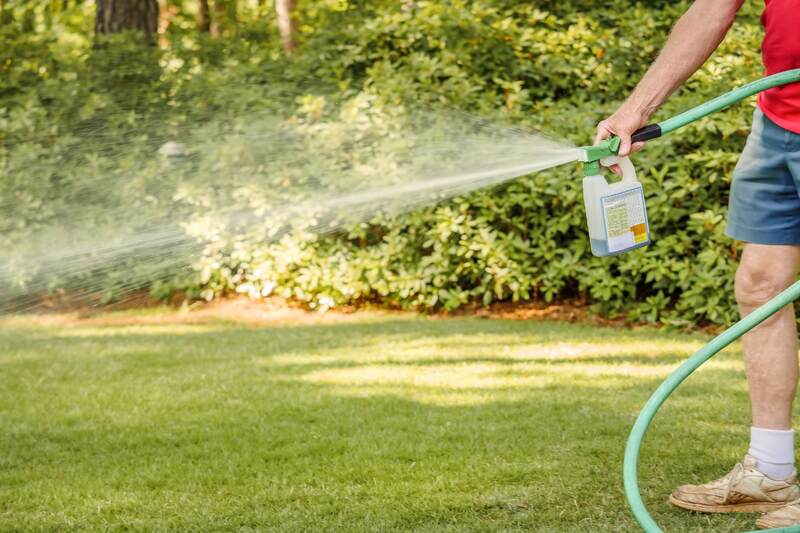
Photo Credit: The Toidi / Shutterstock
Starter fertilizers are sold in liquid and solid (granules, pellets) form. Most experts recommend liquid fertilizer at this stage because it makes phosphorus more easily available to the grassroots. However, granular fertilizer is more popular because it’s less expensive. Here’s a comparison between the liquid and granular fertilizers to help you decide.
| Liquid Fertilizer | Granular Fertilizer |
| Pro: ✓ Easily absorbed in soil ✓ Allows even distribution of nutrients ✓ Roots can access phosphorus easier ✓ Quick-release fertilizers that show fast results ✓ Easy to apply | Pro: ✓ Provides nutrients for longer ✓ Doesn’t have to be applied often ✓ Longer shelf-life than liquid fertilizer ✓ Cheaper than liquid fertilizer |
| Cons: ✘ Can trigger a growth surge ✘ Provides nutrients for a shorter time ✘ Has a shorter shelf-life than granular fertilizer ✘ Is typically more expensive than granular fertilizer | Cons: ✘ Difficult to apply evenly ✘ It’s a slow-release fertilizer and doesn’t act fast enough for some lawns ✘ Contains a higher amount of salt than liquid fertilizer ✘ Some nutrients, like phosphorus, may have difficulty reaching the roots |
Test the Soil to Determine Nutrient Levels
Too much fertilizer applied to soil that is already rich in nutrients can lead to fertilizer burn. The excess fertilizer plants don’t need and can’t absorb accumulates as salts in the ground and can harm your grass.
Test your soil to learn what nutrients your lawn needs and in what amount. Soil test kits are easy to buy online and simple to use.
You also can send a sample to the local Extension Office lab for more detailed results. Lab testing takes about two weeks, but it’s more thorough. You’ll also receive professional advice on the best fertilizers and soil amendments to improve your lawn.
Note: An imbalanced soil pH can prevent your grass from properly absorbing nutrients. If the test shows acidic or alkaline soil, you’ll need to amend it with:
- Lime: See our guide on how to apply lime on acidic soils.
- Sulfur: According to the Riley County Extension, the amount of sulfur to apply depends on the soil type and the pH level. For example, to decrease pH from 7.5 to 6.5, you’ll need 1 to 1.5 lbs. per 100 square feet for sandy soil and 1.5 to 2 lbs. per 100 square feet for loamy soil.
How to Apply Fertilizer for New Grass
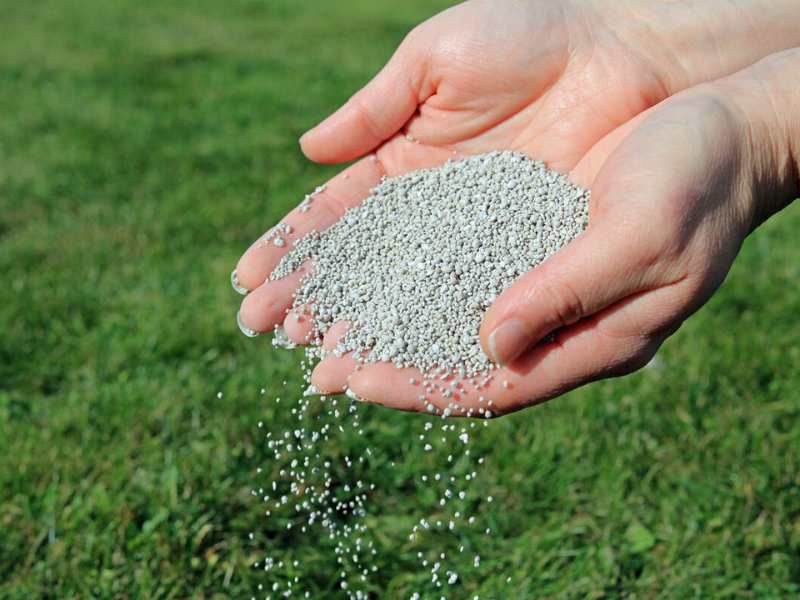
Fertilizing new grass is part of the seeding (or sod installation) process and benefits from the preparation you’ll make for planting the new lawn.
At this stage, most homeowners ask, “Should I fertilize before or after seeding?” Either way is good, but fertilizing before seeding is better. The important thing is to never spread granular fertilizer mixed with your grass seeds. You’ll get uneven grass and uneven fertilizer coverage.
If you install new sod, the best time to fertilize is before you lay the sod strips.
Here are the steps to follow to fertilize new grass safely:
Prepare the Soil
Grass seeds and sod roots need loose, fertile soil, free of any debris, with good airflow and water drainage. To prepare your lawn’s soil properly:
- Remove debris, unwanted grass, and weeds from the area.
- If necessary, remove the thatch. Thatch is a layer of dead organic matter that forms a mat over the soil. If you overseed new grass to thicken an existing lawn, thick thatch might prevent seeds and fertilizers from reaching the soil.
- Aerate the soil if compacted. Core aeration pulls out dirt plugs, leaving tiny holes that improve water and fertilizer access into the soil.
- Apply topdressing. Topdress the soil with a 2-inch thick organic matter (compost) or garden soil. This is an excellent way to ensure good-quality topsoil for grassroots to dig in.
- Water the yard a few days before fertilizing, it helps nutrients disperse easier into the soil.
Note: If you need to get rid of weeds using herbicides, wait two to four weeks before planting new grass (check the waiting time on the label).
Determine the Amount of Fertilizer to Spread
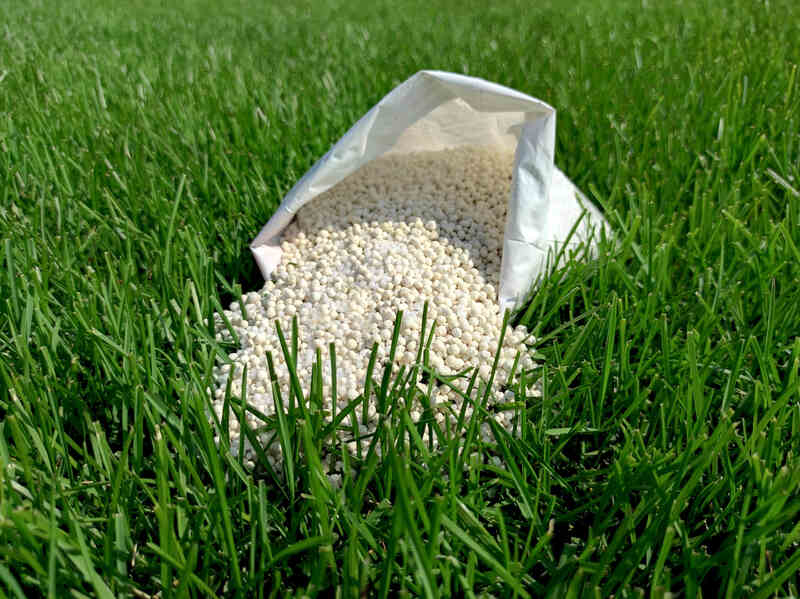
Using too much fertilizer is the most common cause of fertilizer burn. To avoid damaging the grass:
- Measure the seeded area.
- Read the fertilizer instructions to check the recommended amount per 1,000 square feet. (Typically, you’d use 0.5 to 1 lbs. per 1,000 square feet of seeded soil.)
- Measure the amount you put in your spreader. Use a scale or a measuring cup.
- If you’re using liquid fertilizer and must dilute it, follow the label instructions precisely.
- Set the spreading rate as indicated on the fertilizer package. For granular fertilizer, you can use a drop-type or a broadcast spreader. For liquid fertilizer, you’ll need a sprayer and a garden hose.
Apply Starter Fertilizer
- Start from a corner of your lawn and walk back and forth at a steady pace in overlapping strips.
- Turn the spreader off when you need to turn and start a new strip, when you stop for any reason or need to refill the spreader.
- After spreading the fertilizer, work the granules into the soil 4 to 6 inches deep with a rake.
- Always collect any spilled fertilizer from your walkways or driveway to prevent runoff.
Spread Grass Seeds (or Install the Sod)
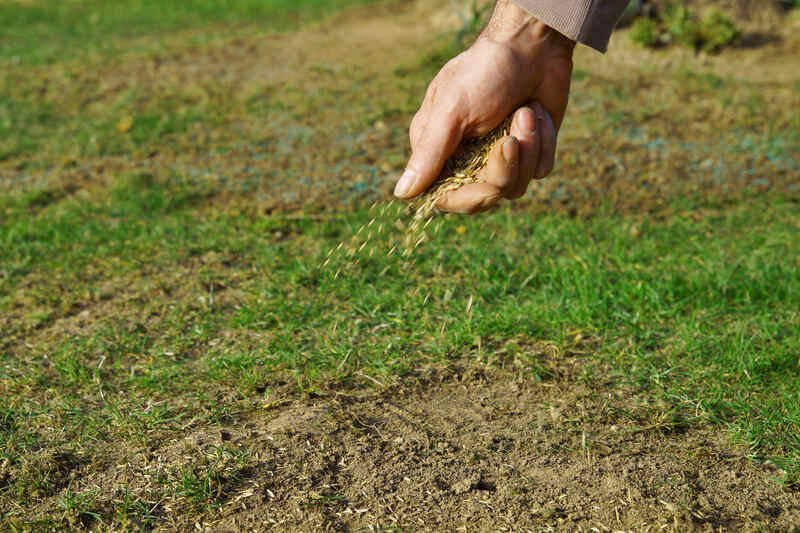
The fertilizer is in, and it’s time to plant grass seed or lay sod strips. Either option you choose, make sure the soil is moist, and the seeds or sod strips have good soil contact.
For detailed information about this stage in the process of installing a new lawn, read our guides about sowing new grass and laying sod.
Water the Lawn
Water helps fertilizers absorb easier and evenly into the soil, grass seeds germinate, and sod roots find their place in their new home. It’s essential to establish a new lawn. Here’s how to water new grass correctly:
- First week: Irrigate two to four times daily in sessions of about 10 minutes until grass seeds germinate. Apply about ⅛ to ¼ inch of water per day.
- Second and third week: Once your lawn is covered in grass seedlings, reduce the number of sessions to one or two a day rather than one session every other day.
- Fourth week: Your new grass has roots, but they’re short and fragile. Now it’s time to start training the roots for deeper and more robust growth. Start watering once or twice weekly with 1 to 1.5 inches of water per week. Add a third irrigation session if hot and dry.
When and How Often Can You Fertilize a New Lawn
To enjoy a healthy lawn, apply starter fertilizer before or after you plant new grass. The best time of year for seeding is:
- Late summer to early fall for cool-season grasses like tall fescue, Kentucky bluegrass, and perennial ryegrass (with a second option in early spring).
- Late spring to early summer for warm-season grasses like Bermuda and Zoysia.
Once the starter fertilizer is applied, the next application should be after six to eight weeks — this is the general recommendation. However, some liquid starter fertilizers can be reapplied after four weeks, especially if your grass grows on sandy soil, which loses nutrients faster.
Six to eight weeks after planting new grass, your lawn is established and fertilization rules change. Learn the right way to fertilize an established lawn from our guides:
Maintaining Your New Lawn to Limit Fertilizer Use
You’ve done it! You’ve got a green lawn, thick as velvet, growing healthy, and thriving. Now what? Now, patience and care. We’ve talked about watering your new grass, here’s what else you can do during its development stage:
- Don’t rush the mowing: Let the grass grow about a half-inch taller than the recommended height before cutting it for the first time. Taller grass grows deeper roots that can access nutrients further in the soil.
- Leave the grass clippings on the lawn: Grass clippings are a natural source of slow-release nitrogen that can feed your lawn without risks. If the grass is free of pests and diseases, leave the clippings on the lawn as mulch.
- Apply organic topdressing (compost, decomposed manure) once a year to improve soil quality.
- Consider homemade fertilizers: You can use meal scraps, coffee grounds and other kitchen scraps to make organic, free and safer homemade fertilizer for your lawn.
FAQ About Fertilizer Damage to New Grass
Can You Overfertilize New Grass?
Yes, applying too much starter fertilizer can damage or kill the new grass and reduce the germination rate. More does not equal better when it comes to fertilizing grass. Stick to the amounts written on the fertilizer label.
Can I Put Seasol on My Newly Seeded Lawn?
Seasol is a good organic fertilizer, but it can’t replace a starter fertilizer when feeding new grass. The main reason is that Seasol has a very low phosphorus content and moderate amounts of nitrogen and potassium. However, it’s a clean, natural fertilizer that adds valuable micronutrients to your lawn after it is established.
Should I Use Starter Fertilizer When Overseeding?
Yes, starter fertilizer is used when installing a new lawn, but also when overseeding or reseeding bare patches in an established lawn.
Call the Fertilizer Pro!
Worried you might kill the new grass with the wrong fertilizer? Don’t sweat it, hire a lawn pro and benefit from their experience. With LawnStarter, the best lawn care professional in your area is only a click away and can cover your yard into the perfect, lush, green lawn you’ve always wanted.
Main Photo Credit: bofotolux / Adobe Stock

